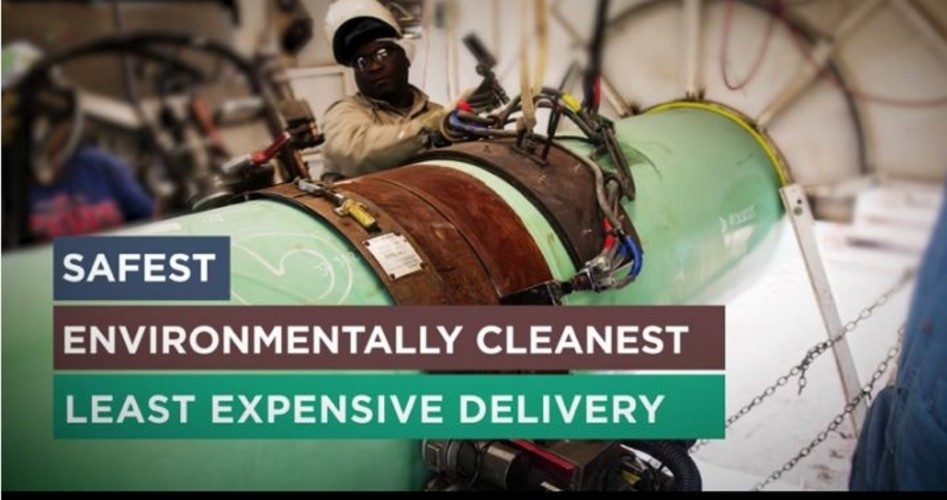
President Donald Trump signed three executive actions on Tuesday reviving action on the Keystone XL and Dakota Access oil pipeline construction projects aborted by former President Obama.
Trump said he wants to seek a “better deal” on the Keystone XL Pipeline and asked TransCanada Corporation to resubmit its application for permission to complete the project. He added, “If we’re going to build pipelines in the United States, the pipes should be made in the United States.” Approvals of both projects are “subject to terms and conditions to be negotiated by us.”
Former President Obama iced the Keystone project in 2015 after seven years of stalling and delays, deciding after all that it wasn’t in the best interests of the United States to complete it. And the U.S. Army Corps of Engineers pulled its prior approval of completion of the Dakota Access pipeline last September following outrage, accompanied by violence, by environmentalist activists and members of Indian tribes allegedly concerned about water pollution and disturbing cultural sites.
Trump was careful to use “executive actions” on Tuesday, instead of “executive orders,” in his nod to move ahead with both projects. As Tom Murse, a contributing writer on U.S. government policies for About.com, noted:
Executive actions are any informal proposals or moves by the president. The term executive action itself is vague and can be used to describe almost anything the president calls on Congress or his administration to do….
A good way to think of executive actions is a wish list of policies the president would like to enact.
Executive orders, on the other hand, “are legally binding directives from the president to federal administrative agencies,” according to Murse.
Trump said his orders were designed to expedite environmental reviews and consequent approvals for these projects considered as “high-priority infrastructure projects.”
Reactions to Trump’s moves were predictable. The price of TransCanada stock jumped three percent following the news, while the stock price of Energy Transfer Partners, the developers of the Dakota Access pipeline project, jumped four percent.
Dave Archambault II, chairman of the Standing Rock Sioux Tribe also jumped at the news:
President Trump is legally required to honor our treaty rights and provide a fair and reasonable pipeline process. The existing pipeline route risks infringing on our treaty rights, contaminating our water, and the water of 17 million Americans downstream.
It’s notable that eight other pipelines already cross Lake Oahe — two with a path similar to the Dakota Access Pipeline that are much nearer to the surface — and the pipeline does not cross the reservation of the Standing Rock Sioux Indians.
Other opponents of the projects weren’t so polite. Travis Nichols, a spokesman from Greenpeace, told reporters:
A powerful alliance of indigenous communities, ranchers, farmers, and climate activists stopped the Keystone pipeline the first time, and the same alliance will come together to stop Keystone again if Trump tries to raise it from the dead.
Even more direct was Josh Nelson, deputy political director of the activist group CREDO:
Fierce grassroots activism has stopped these pipelines over and over again. CREDO will do everything in its power to stop the Dakota Access and Keystone XL pipelines, and keep dirty fossil fuels in the ground where they belong.
350.org, the radical environmentalist group funded with Rockefeller money, issued a threat:
Indigenous peoples, landowners, and climate activists did everything in our power to stop Keystone XL and Dakota Access, and we’ll do it again. These orders will only reignite the widespread grassroots opposition to these pipelines and other dirty energy projects.
Trump is about to meet the fossil fuel resistance head on.
When completed, the Keystone XL pipeline will carry Canadian tar sands crude to refineries on the Gulf Coast, to refine it into gasoline and other petroleum-based products. At issue is an estimated 800,000 barrels a day, a lot of which is being transported to refineries by rail.
The Dakota Access pipeline, when it is completed, will bring an estimated 500,000 barrels of crude every day from the Bakken oil fields in North Dakota through South Dakota and Iowa, ending up at a tank farm in Patoka, Illinois.
What Trump’s executive actions do is alert his administration that approving these two projects is very high on his list of priorities and that more delays are unacceptable: “We intend to fix our country, our bridges, our waterways. We can’t be in an environmental process for 15 years.”
An Ivy League graduate and former investment advisor, Bob is a regular contributor to The New American magazine and blogs frequently at LightFromTheRight.com, primarily on economics and politics. He can be reached at [email protected].



